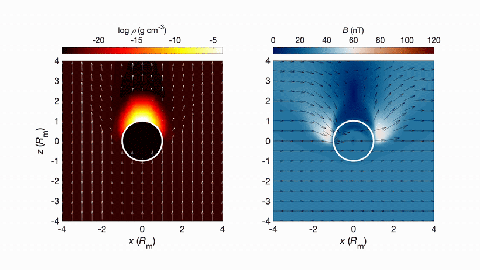Scientists may have solved the mystery of how the moon was magnetized

Credit: Science Advances, doi: 10.1126/sciadv.abb1475
The mystery of how the Moon got a magnetic field and what happened to it has baffled scientists for decades. New research explains why the Moon’s crust is magnetized by debunking one long-standing theory.
While the Moon doesn’t currently have a global magnetic field, analysis of rocks gathered by Apollo astronauts suggested that it used to be strongly magnetized about 3.56 to 4.25 billion years ago. As some of the rocks were magnetic, scientists estimated that parts of the lunar crust still exhibit traces of magnetization for hundreds of miles.
The new study’s co-author, Australian researcher Dr. Katarina Miljkovic, from the Curtin Space Science and Technology Centre at Curtin University, sees their work as a continuation of efforts by previous scientists:
“There are two long term hypotheses associated with why the Moon’s crust might be magnetic: One is that the magnetisation is the result of an ancient dynamo in the lunar core, and the other is that it’s the result of an amplification of the interplanetary magnetic field, created by meteoroid impacts,” Dr. Miljkovic shared in a press release.
The research her team carried out is a “deep numerical study” that looks at the theory that the magnetization is influenced by impacts and essentially disproves it. Dr. Miljkovic says the collisions were not responsible because they “found that meteoroid impact plasmas interact much more weakly with the Moon compared to the magnetisation levels obtained from the lunar crust.” As such, the scientists concluded that the core dynamo is the “the only plausible source of the magnetisation of the Moon’s crust.”
Dr. Miljkovic’s research involved calculating the mass and thermal energy of the vapor generated during violent impacts about 4 billion years ago, as evidenced by the craters we can see just by looking up at night.
Moon mission 2.0: What humanity will learn by going back to the Moon | Michelle Thaller | Big Thinkwww.youtube.com
Dr. Rona Oran, the lead researcher of the study, from the Massachusetts Institute of Technology (MIT), said that modern computing power allowed them to run impact and plasma simulations that were previously impossible to carry out. This also allowed them to rule out ideas.
“In addition to the Moon, Mercury, some meteorites, and other small planetary bodies all have a magnetic crust,” stated Dr. Oran. “Perhaps other equivalent mechanical dynamo mechanisms, such as those we now believe to have been in operation on the Moon, could have been in effect on these objects as well.”
Check out the study published by Science Advances.





